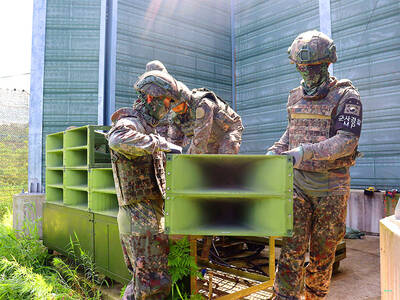Venezuelan President Hugo Chavez's efforts to curb the influence of the US in the developing world range from creating a leftist TV network for Latin America to selling cheap oil to his allies, but few of his projects were begun as enthusiastically as the Bank of the South.
Now, the fervor surrounding the Bank of the South, a project heralded here as a regional financing alternative to Washington-based institutions like the World Bank and Inter-American Development Bank, has cooled as Brazil seeks to diminish the new bank's clout.
Ahead of a meeting in Rio de Janeiro, Brazil, set for next month, at which the bank's creation is expected to be formally announced, Venezuela and Brazil have diverged on its base of operations, size, startup capital and mission, according to people briefed on the negotiations.
The diverging views of the project point to contrasts between Brazilian President Luiz Inacio Lula da Silva, a longtime socialist who embraced market-friendly policies once in power in Latin America's largest country, and Chavez, who favors a more assertive role for Venezuela's government in guiding economic policy here and elsewhere in the region.
Some sectors in Brazil are chafing at Chavez's ambitions to lead integration efforts. At the same time, tension persists over a spat between Chavez and Brazil's Senate over Venezuela's pushing a critical television network off its public airwaves -- a move many in Brasilia saw as stifling dissent -- and Chavez's recent criticism of the use of food crops to produce automotive fuels, a cornerstone of Brazil's economy.
"Brazil has demonstrated its conservatism in relation to Venezuela's thinking," said Vince McElhinny, a Latin America analyst at the Bank Information Center, a Washington group that tracks development banks. "A project that began with enthusiasm over egalitarian principles is dealing with Brazil's decisiveness in trying to limit its scope."
Venezuelan officials, who want the Bank of the South to be based in Caracas, have had to deal with Brazilian proposals to have it function from a smaller capital such as Montevideo, Uruguay, or Asuncion, Paraguay.
Also, Venezuelan ambitions for the bank to start operations with US$7 billion in capital have been countered by Brazil's more modest suggestion of US$3 billion.
Discussions around forming the bank have also focused on how many technical employees each country can nominate, whether financing should come from each country's foreign currency reserves and how transparent the bank's lending policies should be.
In addition, Brazil would prefer to limit membership to South American countries, while Venezuela wants to include Central America and the Caribbean, which would allow Chavez allies Nicaragua and Cuba to become shareholders.
"We want the bank to be tied to Unasur," Marco Aurelio Garcia, the international affairs adviser to Brazil's president, said in a telephone interview, referring to a fledgling intergovernmental union whose structure has yet to be determined.
"The negotiations involve the question of pace," he said.
Some countries, especially Bolivia and Ecuador, see the Bank of the South as a way to dilute the influence of the World Bank and IMF.
The conflict between Brazil and Venezuela over the bank is just one level of its obstacles. There are also critics of Chavez who note that Latin America already has native development banks that are flourishing. One is the Corporacion Andina de Fomento, based in Caracas and created in the 1970s. It has grown beyond its original focus on Andean countries, adding as shareholders Brazil and Spain and more than a dozen private banks in the region. Another is BNDES, the Brazilian development bank, whose lending already dwarfs that of the Inter-American Development Bank.

Authorities have detained three former Taiwan Semiconductor Manufacturing Co (TMSC, 台積電) employees on suspicion of compromising classified technology used in making 2-nanometer chips, the Taiwan High Prosecutors’ Office said yesterday. Prosecutors are holding a former TSMC engineer surnamed Chen (陳) and two recently sacked TSMC engineers, including one person surnamed Wu (吳) in detention with restricted communication, following an investigation launched on July 25, a statement said. The announcement came a day after Nikkei Asia reported on the technology theft in an exclusive story, saying TSMC had fired two workers for contravening data rules on advanced chipmaking technology. Two-nanometer wafers are the most

Tsunami waves were possible in three areas of Kamchatka in Russia’s Far East, the Russian Ministry for Emergency Services said yesterday after a magnitude 7.0 earthquake hit the nearby Kuril Islands. “The expected wave heights are low, but you must still move away from the shore,” the ministry said on the Telegram messaging app, after the latest seismic activity in the area. However, the Pacific Tsunami Warning System in Hawaii said there was no tsunami warning after the quake. The Russian tsunami alert was later canceled. Overnight, the Krasheninnikov volcano in Kamchatka erupted for the first time in 600 years, Russia’s RIA

CHINA’s BULLYING: The former British prime minister said that he believes ‘Taiwan can and will’ protect its freedom and democracy, as its people are lovers of liberty Former British prime minister Boris Johnson yesterday said Western nations should have the courage to stand with and deepen their economic partnerships with Taiwan in the face of China’s intensified pressure. He made the remarks at the ninth Ketagalan Forum: 2025 Indo-Pacific Security Dialogue hosted by the Ministry of Foreign Affairs and the Prospect Foundation in Taipei. Johnson, who is visiting Taiwan for the first time, said he had seen Taiwan’s coastline on a screen on his indoor bicycle, but wanted to learn more about the nation, including its artificial intelligence (AI) development, the key technology of the 21st century. Calling himself an

South Korea yesterday said that it was removing loudspeakers used to blare K-pop and news reports to North Korea, as the new administration in Seoul tries to ease tensions with its bellicose neighbor. The nations, still technically at war, had already halted propaganda broadcasts along the demilitarized zone, Seoul’s military said in June after the election of South Korean President Lee Jae-myung. It said in June that Pyongyang stopped transmitting bizarre, unsettling noises along the border that had become a major nuisance for South Korean residents, a day after South Korea’s loudspeakers fell silent. “Starting today, the military has begun removing the loudspeakers,”